Historic Attractions in St. Augustine Florida
You are walking through the streets of an ancient city, where the territory was once controlled by natives, and then by the English, Spanish, and French explorers. Where once upon a time pirates pillaged and with the help of providence and a mighty hurricane, the English Armada removed and obliterated not only a French fort but their considerable fleet as well. Where would you be? By the description you must be St. Augustine, Florida – the oldest European settlement, and for many, the most charming old city in the United States.
As you might imagine, a city with this depth of history naturally has a unique blend of charm where old meets new unlike anywhere else in the United States. Saint Augustine is a magnet for historians, people who enjoy the arts, artists}, sun-seekers, families of ALL ages, newlyweds, and water enthusiasts alike.
There are many worthwhile St. Augustine historic sites to visit. After all, our title, the “nation’s oldest city” brings with it an abundance of interesting St. Augustine history. I think many visitors are quite surprised to find out just how much there is to do here. To see all we have to offer, plan to spend several days.
St Augustine can be found on the eastern coast of Florida about 40 miles south of the Florida capital of Jacksonville, the Old City as it is known is a delightful blend of romance and things to do and see.
Castillo de San Marcos National Monument
Castillo de San Marcos……right in the heart of St. Augustine, overlooking the inlet, you will find our world-famous St. Augustine fort, the Castillo de San Marcos.
When the children were small we used to pack our books and head to the fort on our bikes. The moat wall surrounding our St. Augustine fort was one of our favorite places to hold classes (we homeschooled). Although I must say, with gulls flying overhead and a multitude of boats going by it was a bit difficult to concentrate.
Castillo de San Marcos quick and interesting facts:
- Built on the point in the 1600s, the fort offered protection for the citizens of St. Augustine and provided a safe haven for Spanish ships laden with treasure.
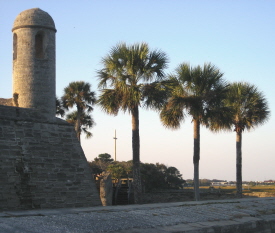 It is the largest and oldest stone masonry fort in the continental United States. The scarred original walls, constructed of coquina rock, are 16 feet wide at the base and 33 ft high.
It is the largest and oldest stone masonry fort in the continental United States. The scarred original walls, constructed of coquina rock, are 16 feet wide at the base and 33 ft high.- The Castillo, which has never been taken in battle, has had five flags flown overhead; Spanish, British, Spanish again, Confederate and American.
- Today, the St. Augustine fort is operated by the National Park Service.
*Colonial Spanish Quarter– a living history museum representing 1740’s St. Augustine.
Mission Nombre de Dios
America’s first mission and site of the founding of St. Augustine in 1565. Look for the 200-foot cross towering above the city’s most historic grounds.
Look for the 208 ft. stainless steel cross rising above the trees on the banks of the Matanzas River and you will have found it. It was here in 1565 that Pedro Menendez de Aviles landed and claimed the land for Spain and the Church.
Father Francisco Lopez de Mendoza Grajales, his chaplain, came ashore and held the first parish Mass on this site, now recognized as the birthplace of Christianity in the United States.
There are many interesting and historic buildings and memorials throughout the Mission grounds.
- Prince of Peace Church – built in 1965 of coquina to commemorate the Four Hundredth Anniversary of the Mission.
- Father Lopez statue – a bronze memorial just over the footbridge.
- The Cross – a reminder of Christ’s ultimate sacrifice on the cross. Also, a tribute to the Catholic Church for their role in the history of Florida and our Nation.
- Our Lady of La Leche Chapel and Shrine – old Spanish style chapel of Our Lady of the Milk and Happy Delivery.
- Archaeological Excavations – work conducted on the Mission grounds by the University of Florida unearthed one of the earliest Spanish fortifications in Florida.
I highly recommend visiting this peaceful and beautiful site.
There is no fee although donations are gratefully accepted and appreciated.
Mission of Nombre de Dios
27 Ocean Avenue
St. Augustine FL 32084
(904) 824-2809
Lightner Museum
The Lightner Museum is a “treasure” full of “treasures” right in the heart of St. Augustine. Three floors full of beautiful, gilded age relics are on exhibit for all to see. The setting for this magnificent exhibit is the old Alcazar Hotel, built in the Spanish style by Henry Flagler in 1888.
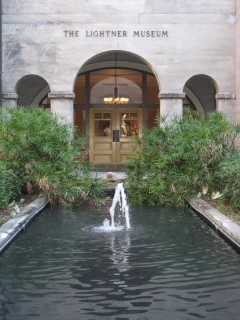 The building is impressive with it’s large reflection pool and gardens. Inside you’ll find an extensive collection that includes objects from daily life in the 19th and early 20th centuries.
The building is impressive with it’s large reflection pool and gardens. Inside you’ll find an extensive collection that includes objects from daily life in the 19th and early 20th centuries.
Everything from the luxurious to the ordinary; costumes, musical instruments, cut glass, and stained glass work by Louis Comfort Tiffany.
The musical instrument collection has a working orchestrion and a self-playing violin and piano.
Billed as the “Florida Smithsonian”, there is something of interest for everyone.
On the lower level is the delightful and delicious Café Alcazar which is located in what was once the indoor swimming pool. Browse the museum then head down to the café for a tasty lunch.
Lightner Museum
75 King St
St Augustine Fl 32084
(904) 824-2874
Oldest House Museum
I know I keep saying it but this is another “must-do”. The Oldest House is fascinating. The St. Augustine Historical Society operates the museum which they acquired in 1918.
The complex consists of the Gonzalez-Alvarez House, Manucy Museum, Tovar House, Page Edwards Gallery, Gardens, and the Museum Store.
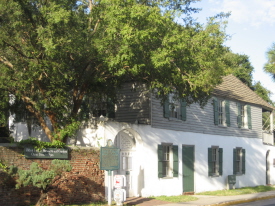
The Gonzalez-Alvarez House designated a National Historic Landmark in 1970, is known as the Oldest House.
I find it hard to believe a structure from the early 1700s is still standing but here it is.
When you visit the house you will get a sense of the daily lives of settlers in early Florida.
The Page Edwards Gallery offers changing exhibits drawn from Florida’s rich history.
The Manucy Museum, located in the 1924 Webb Building, presents 400 years of Florida history and the 1740’s Tovar House traces Florida’sdistinguished military history from the Colonial Period to the Persian Gulf war.

The Museum Store has St. Augustine’s best selection of books on local and Florida history. So all you history buffs be sure to stop in the store and pick up a book.
Do you have anything you think will still exist 300 years from today? I can’t think of anything I have.
Amazing when you stop and think about it!
Oldest House MuseumSt. Augustine Historical Society
14 St. Francis St.
St. Augustine FL 32084
(904) 824-2872
Colonial Spanish Quarter
The Colonial Spanish Quarter, a living history museum, is one of my favorites. The setting is 1740; costumed interpreters go about their daily life just as it was several hundred years ago in historic Spanish Florida.
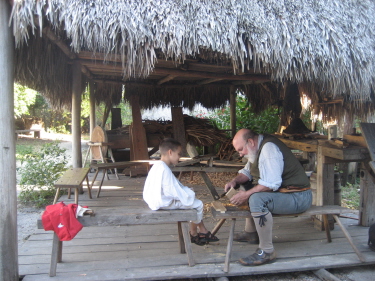
Within the two-acre village are several houses, shops, and a tavern. Craftsmen, soldiers, housewives, and merchants enjoy sharing their wealth of knowledge with visitors.
The newest project is the building of the Coopers and Treenware Makers shed. The cooper made buckets and repaired barrels and the treenware maker made wooden utensils. The shed has been built with construction methods that would have been used in the 18th Century.
This is a great place to experience early life in St. Augustine.
Colonial Spanish Quarter
53 St. George St.
St. Augustine FL 32084
(904) 825-6830
Spanish Military Hospital Museum
The Spanish Military Hospital Museum brings you fascinating St. Augustine history!
You’ll find out just what it was like to be a patient in 1791 at this wonderful Florida museum. The building is a reconstruction of a military hospital that stood on this actual site during the Second Spanish Colonial Period from 1784 – 1821.
Medicine has certainly come a long, long way in the last several hundred years and I for one, am quite grateful. After you finish your tour, I think you will agree.
You’re going to learn firsthand the advanced medical practices of the Spanish who have licensed Physicians since the 16th century.
On your guided tour you will visit the Mourning Room and the Surgeon’s Office complete with his surgical tools explained and demonstrated by your guide. Then travel to the Wardroom and learn of the strict regulations of the Royal Hospital. Did you know that the Spanish required their Surgeon to wash their hands before touching a patient in a time where germs had not been realized? Wait until you see the “tools” that were used; quite frightening and the beds didn’t look any too comfortable either.
The Apothecary was in charge of the making of the medicines and many of the medicines that we use today are derived from the herbs that he used 300 hundred years ago. End your tour with a visit to the herb garden and display room which features medical instruments and tools from centuries past.
I highly recommend this wonderful Florida museum full of fascinating St. Augustine history. It is fun, educational (don’t tell the kids), and very reasonable. Be sure to add the Spanish Military Hospital Museum to your “must-do” list.
Spanish Military Hospital Museum3 Aviles St.
St. Augustine FL 32084
(800) 597-7177
(904) 827-0807
Villa Zorayda Museum
The Villa Zorayda is a treasure well worth exploring whether you are a visitor or a local. I had no idea we had such an incredible home right here in the heart of St. Augustine.
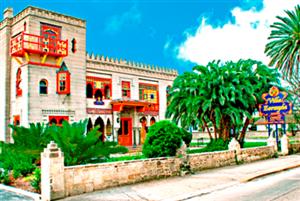 The elegant and historic Villa recently re-opened after a multi-year extensive renovation. The results are remarkable.
The elegant and historic Villa recently re-opened after a multi-year extensive renovation. The results are remarkable.
On the “National Register of Historic Places,” it is a 1/10th scale replica of a small portion of the Moorish Castle, The Alhambra Palace, in Granada, Spain.
You’ll step back in time as you enter this grand Gilded Age home built by Franklin W. Smith in 1883.
Inside, you’ll see intricate traceries(ornamental work) on the walls made of alabaster and plaster. These were constructed in Spain and brought over by ship in the mid-1800s.
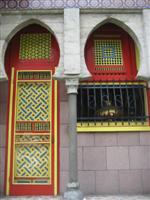 Beautiful tiles, over 350 years old from Egypt and Spain, line the walls and floor of the Villa.
Beautiful tiles, over 350 years old from Egypt and Spain, line the walls and floor of the Villa.
The Villa Zorayda was the winter home of Franklin Smith and his family until 1904 when Mr. Smith decided to lease it out. It then became the Zorayda Club, featuring dining and dancing.
In 1913, Abraham S. Mussallem bought the Villa Zorayda and the neighboring Granada Hotel (which he renamed the Alhambra Hotel). He continued to lease out the Villa keeping it as the Zorayda Club for several more years.
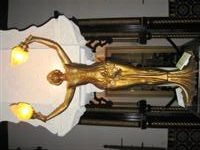 The 1920s brought casino gambling to the Villa until it was outlawed in the late ’20s by the State of Florida. In 1934, Abraham & his wife, Olga, opened the Villa as a museum and it has remained a museum ever since.
The 1920s brought casino gambling to the Villa until it was outlawed in the late ’20s by the State of Florida. In 1934, Abraham & his wife, Olga, opened the Villa as a museum and it has remained a museum ever since.
day, you’ll find the original antique collections of both Franklin W. Smith and Abraham S. Mussallem.
Abraham Mussallem was an authority on Egyptian artifacts, oriental rugs, and fine antiques.
The Villa was built before electricity was introduced to St. Augustine so most of the beautiful brass lamps and Moorish light fixtures were originally gas lamps or lanterns that have been converted to electricity.
On display is antique furniture which dates back to the 1600s, a collection of porcelain china from the Zorayda Club days as well as a set of 21 watercolors built into the wainscoting of the house which was painted in 1881, at the “School of Fine Arts” in Paris, France, just to name a few. You’ll also see what was found behind the watercolors during the renovation. Very interesting!
Don’t step on the Egyptian Cat Rug – a 2400-year-old rug made from hairs of ancient cats that roamed the Nile River – it possesses a curse for anyone who walks on it! Look for it in the Egyptian Room.
Villa Zorayda
83 King Street
St. Augustine, Florida 32084
(904) 829-9887
Oldest Wooden Schoolhouse
Located on the north end of St. George Street, the Oldest Wooden Schoolhouse dates back to the early 1700s.
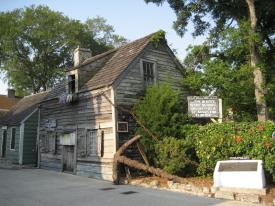 Even though it appeared on the tax roles in 1716, it is thought that it was built several years earlier.
Even though it appeared on the tax roles in 1716, it is thought that it was built several years earlier.
The building is constructed of red cedar and cypress with handmade wooden pegs holding the timbers in place.
Today, you will see a huge chain tied to an anchor wrapped around this little schoolhouse. It was added in 1937 when a hurricane threatened St. Augustine. Looks like it worked!
There were no conveniences at all; no electricity, running water, bathroom, or kitchen. A well, privy, and kitchen were all out back. A sign of the times for our old, old buildings.
When the original owner of the house Juan Genoply married, the house became a school and an addition was built. The schoolmaster and his family lived upstairs.
The Oldest Wooden Schoolhouse became the first co-ed school beginning in 1788.
As you walk through the beautiful gardens you will find the kitchen, the privy, and the well. Be sure not to miss the large pecan tree. It is said to be 250 years old and still bearing nuts.
Sit a spell in the quiet, peaceful gardens; unless you happen to visit the same time as a school group, then isn’t quite so quiet or peaceful, but it is always fun.
Oldest Wooden Schoolhouse
14 St. George Street
St. Augustine FL 32084
(888) 653-7245
Fountain Of Youth St Augustine
I’m pretty sure that the Fountain of Youth is now my favorite place to visit ever. We traveled this past weekend to St. Augustine for a conference, but we had to Home The Fountain of Youth, St. Augustine, FL.
The Fountain of Youth harkens back to the days when A1A was the main road and schlock was king. Fun for its tackiness and cheesiness, reminiscent of a 5th-grade social studies strip slide projector presentation.
Visit the spot where a nation’s history was born. The Fountain of Youth Archaeological Park is where St. Augustine was founded nearly 450 years ago after explorer Pedro Menendez de Aviles arrived from Spain.
Ponce de Leon’s World-Famous Fountain of Youth
11 Magnolia Avenue
St. Augustine FL 32084
(904) 829-3168
(800) 356-8222
Flagler College
Downtown St. Augustine is home to Flagler College, ranked for more than a decade by U.S. News and World Report as one of America’s Best Colleges.
Now, why do I have it listed as a historic site? Because of the building, it is housed in, the former Hotel Ponce de Leon was built by Henry Flagler in the late 1800s.
No expense was spared; Tiffany windows, mosaics, ornate murals, and Spanish Renaissance architecture all contributed to this grand hotel becoming a playground of the rich and famous.
Thomas Edison personally assisted with the wiring to make this hotel the first building in Florida with electricity. Architects, John Carrere, and Thomas Hastings, launched their very successful careers at the HotelPonce de Leon.
Flagler College
74 King St.
St. Augustine FL 32084
(904) 819-6481
St Augustine Lighthouse
Climb 219 steps to the top of the St Augustine Lighthouse fora view you won’t soon forget.
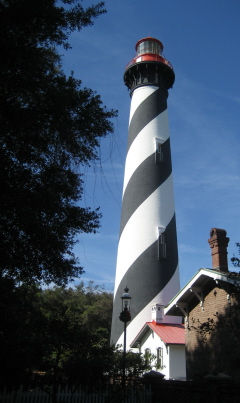 It’s breathtaking; and not just from climbing all those stairs!
It’s breathtaking; and not just from climbing all those stairs!
There are eight landings, one with a bench for resting as you make your way to the top. It really is quite a workout.
There is no elevator as such things didn’t exist in 1874!
It took three years, from 1871 – 1874, to build the Lighthouse. In 1876 the brick light keeper’s house was added. It was used by the lightkeepers and their assistants until the light was automated in 1955.
The top of the tower is 165 feet above sea level. The beacon is a first-order Fresnel lens that consists of 370 hand-cut glass prisms arranged in a beehive shape.
It remains an active aid to navigation today. You can see the light from almost anywhere in the area after dark.
In 1970 a fire gutted the Keeper’s House. The Junior Service League took on the restoration project in 1980 and opened the museum to the public in 1988. Their successful preservation effort has become a model for other lighthouses nationwide.
The Museum features several exhibits and stores a vast collection of WWII artifacts.
Allow at least an hour to tour the site and climb the tower. Unique maritime gifts and lighthouse replicas can be found in the museum store.
St Augustine Lighthouse and Museum
81 Lighthouse Avenue
St Augustine FL 32080
The Old Jail
Henry Flagler decided he didn’t want the jail anywhere near his luxurious hotels, so he built the Old Jail just outside of town. The Queen Ann style stucco on the brick building was built to resemble a fine hotel and is on the National Register of Historic Places.
The jail was completed in 1891 and housed up to 72 prisoners for 60 years. It is one of the few surviving 19th-century jails in the state. You can explore the sheriff’s quarters where he and his family lived adjacent to the jail. Certainly not my choice of living quarters!
You’ll also see the male and female cells, the maximum security area, and a large collection of used weapons. A 30-minute guided tour is available with costumed deputies sharing tales of justice and punishment.
This is a fun, inexpensive stop on your way around town. There is plenty of free parking available. The Old Jail is also the headquarters for the Old Town Trolley Tours and the Ghost and Gravestone tour. Let us know about your visit to the Old Jail. Click here to send us your review.
Old Jail
167 San Marco Ave
St. Augustine FL 32084
Saint Photios Greek Shrine
The Saint Photios Greek Orthodox National Shrine, an institution of the Greek Orthodox Archdiocese of America, is dedicated to the first colony of Greek people who came to America in 1768.
I have to tell you, I must have walked past the entrance to the Greek Shrine hundreds of times and it wasn’t until just yesterday that I stopped in. I was speechless! It is absolutely breathtaking.
Within the Shrine are exquisite Byzantine style frescoes of scenes from the life of Christ, and many apostles and saints of the Christian church.
The picture here cannot begin to show the beauty and vivid colors of these frescoes. The abundant use of 22 Karat gold leaf on the highlights of the frescoes adds an incredibly vibrant luster.
The Shrine consists of exhibits depicting the story of the First Greek Colony and the St. Photios Chapel. You’ll find various artifacts, photographs, and historical documents. There is also an audio/visual tape, “Our Plymouth Rock” that you might enjoy.
You’ll exit into a tiny store of Greek treasures where I am sure you will find a special memento of your visit. Called the “jewel of St. George Street”, I couldn’t agree more. This is a wonderful stop, a “must-do”.
St. Photios Greek Orthodox National Shrine
41 St. George St
St. Augustine FL 32084
(904) 829-8205
* Dow Museum of Historic Houses (formerly Old St. Augustine Villages) – nine historic homes dating from 1790 to 1910.
* Saint Photios Greek Orthodox National Shrine – dedicated to the first colony of Greek people who came to America in 1768
Historic St. Augustine Churches
You’ll find many beautiful historic sites & churches as you explore St. Augustine, many built in the 1800s. Be sure to allow a few hours during your visit to tour these lovely churches.
St. Augustine History
Living here, I tend to forget just how much history there is. Many of the schools from around the state bring their fourth-grade students here on field trips. A great place to experience Florida history!
